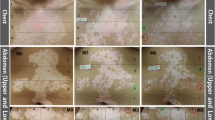Abstract
The present study was designed to evaluate the effect of combining fractional CO2 laser with narrow-band ultraviolet B (NB-UVB) versus NB-UVB in the treatment of non-segmental vitiligo. The study included 20 patients with non-segmental stable vitiligo. They were divided into two groups. Group I received a single session of fractional CO2 laser therapy on the right side of the body followed by NB-UVB phototherapy twice per week for 8 weeks. Group II received a second session of fractional CO2 laser therapy after 4 weeks from starting treatment with NB-UVB. The vitiligo lesions were assessed before treatment and after 8 weeks of treatment by VASI. At the end of the study period, the vitiligo area score index (VASI) in group I decreased insignificantly on both the right (−2.6%) and left (−16.4%) sides. In group II, VASI increased insignificantly on the right (+14.4%) and left (+2.5%) sides. Using Adobe Photoshop CS6 extended program to measure the area of vitiligo lesions, group I showed a decrease of −1.02 and −6.12% in the mean area percentage change of vitiligo lesions on the right and left sides, respectively. In group II the change was +9.84 and +9.13% on the right and left sides, respectively. In conclusion, combining fractional CO2 laser with NB-UVB for the treatment of non-segmental vitiligo did not show any significant advantage over treatment with NB-UVB alone. Further study of this combination for longer durations in the treatment of vitiligo is recommended.


Similar content being viewed by others
References
Alikhan A, Felsten LM, Daly M, Petronic-Rosic V (2011) Vitiligo: a comprehensive overview part I. Introduction, epidemiology, quality of life, diagnosis, differential diagnosis, associations, histopathology, etiology, and work-up. J Am Acad Dermatol 65(3):473–491
Forschner T, Buchholtz S, Stockfleth E (2007) Current state of vitiligo therapy—evidence-based analysis of the literature. J Dtsch Dermatol Ges 5(6):467–475
Welsh O, Herz-Ruelas ME, Gomez M, Ocampo-Candiani J (2009) Therapeutic evaluation of UVB-targeted phototherapy in vitiligo that affects less than 10% of the body surface area. Int J Dermatol 48(5):529–534
El-Zawahry BM, Bassiouny DA, Sobhi RM, Abdel-Aziz E, Zaki NS, Habib DF et al (2012) A comparative study on efficacy of UVA1 vs. narrow-band UVB phototherapy in the treatment of vitiligo. Photodermatol Photoimmunol Photomed 28(2):84–90
Anbar TS, Westerhof W, Abdel-Rahman AT, Ewis AA, El-Khayyat MA (2008) Effect of one session of ER:YAG laser ablation plus topical 5Fluorouracil on the outcome of short-term NB-UVB phototherapy in the treatment of non-segmental vitiligo: a left-right comparative study. Photodermatol Photoimmunol Photomed 24(6):322–329
Abd El-Samad Z, Shaaban D (2012) Treatment of localized non-segmental vitiligo with intradermal 5-flurouracil injection combined with narrow-band ultraviolet B: a preliminary study. J Dermatolog Treat 23(6):443–448
Esfandiarpour I, Ekhlasi A, Farajzadeh S, Shamsadini S (2009) The efficacy of pimecrolimus 1% cream plus narrow-band ultraviolet B in the treatment of vitiligo: a double-blind, placebo-controlled clinical trial. J Dermatolog Treat 20(1):14–18
Shin J, Lee JS, Hann SK, Oh SH (2012) Combination treatment by 10 600 nm ablative fractional carbon dioxide laser and narrowband ultraviolet B in refractory nonsegmental vitiligo: a prospective, randomized half-body comparative study. Br J Dermatol 166(3):658–661
Hamzavi I, Jain H, McLean D, Shapiro J, Zeng H, Lui H (2004) Parametric modeling of narrowband UV-B phototherapy for vitiligo using a novel quantitative tool: the Vitiligo Area Scoring Index. Arch Dermatol 140(6):677–683
Wyffels JT, Edsberg LE (2011) Granulation tissue of chronic pressure ulcers as a predictive indicator of wound closure. Adv Skin Wound Care 24(10):464–473
Li L, Wu Y, Sun Y, Qiu L, Gao XH, Chen HD (2015) Triple combination treatment with fractional CO2 laser plus topical betamethasone solution and narrowband ultraviolet B for refractory vitiligo: a prospective, randomized half-body, comparative study. Dermatol Ther 28(3):131–134
Lin M, Zhang BX, Shen N, Dong XJ, Zhang C, Qi XY et al (2014) Regulatory T cells from active non-segmental vitiligo exhibit lower suppressive ability on CD8+CLA+ T cells. Eur J Dermatol 24(6):676–682
Makboul M, Makboul R, Abdelhafez AH, Hassan SS, Youssif SM (2014) Evaluation of the effect of fractional CO2 laser on histopathological picture and TGF-beta1 expression in hypertrophic scar. J Cosmet Dermatol 13(3):169–179
van Geel N, Speeckaert R, Mollet I, De Schepper S, De Wolf J, Tjin EP et al (2012) In vivo vitiligo induction and therapy model: double-blind, randomized clinical trial. Pigment Cell Melanoma Res 25(1):57–65
Helou J, Maatouk I, Obeid G, Moutran R, Stephan F, Tomb R (2014) Fractional laser for vitiligo treated by 10,600 nm ablative fractional carbon dioxide laser followed by sun exposure. Lasers Surg Med 46(6):443–448
Kumar R, Parsad D, Kanwar AJ, Kaul D (2011) Altered levels of Ets-1 transcription factor and matrix metalloproteinases in melanocytes from patients with vitiligo. Br J Dermatol 165(2):285–291
Wu CS, Yu CL, Lan CC, Yu HS (2004) Narrow-band ultraviolet-B stimulates proliferation and migration of cultured melanocytes. Exp Dermatol 13(12):755–763
Vachiramon V, Chaiyabutr C, Rattanaumpawan P, Kanokrungsee S (2016) Effects of a preceding fractional carbon dioxide laser on the outcome of combined local narrowband ultraviolet B and topical steroids in patients with vitiligo in difficult-to-treat areas. Lasers Surg Med 48(2):197–202
Author information
Authors and Affiliations
Corresponding author
Ethics declarations
Conflict of interest
The authors declare that they have no conflict of interest.
Funding source
None.
Informed consent
Informed consent was obtained from all individual participants included in the study and the study was approved by the ethical committee of the dermatology department.
Rights and permissions
About this article
Cite this article
El-Zawahry, M.B., Zaki, N.S., Wissa, M.Y. et al. Effect of combination of fractional CO2 laser and narrow-band ultraviolet B versus narrow-band ultraviolet B in the treatment of non-segmental vitiligo. Lasers Med Sci 32, 1953–1958 (2017). https://doi.org/10.1007/s10103-017-2290-y
Received:
Accepted:
Published:
Issue Date:
DOI: https://doi.org/10.1007/s10103-017-2290-y




